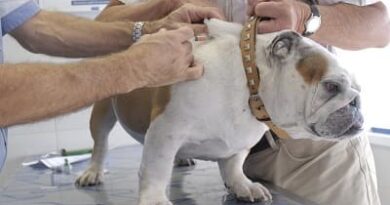Euthanasia in Dogs
Euthanasia in Dogs
Euthanasia is a veterinary procedure in which the death of an animal is induced by non-cruel and painless methods, to avoid the suffering associated with an incurable disease. It is, without a doubt, one of the most complicated decisions for both veterinarians and caregivers, since it means accepting death as the best option.

What is euthanasia in dogs?
The term euthanasia comes from the Greek “ eu ” which means “good”, and “thanatos” which means “death”, so it is literally translated as “ good death ”.
The legislation on the protection of companion animals defines euthanasia as <the death caused to an animal, by non-cruel and painless methods, to avoid useless suffering as a result of an illness or injury with no possibility of cure, which prevents it from having a quality of life compatible with the minimum parameters of animal welfare> .
In other words, it is a veterinary procedure that involves the death of an animal to avoid the suffering or pain associated with an incurable disease or disorder that reduces its quality of life. Therefore, we can deduce two key aspects within the concept of euthanasia:
On the one hand, that there is no prospect of a cure .
On the other hand, that there is no suffering or pain in proportionate death.
Anything that does not meet these two premises will not be considered euthanasia but rather sacrifice.
Types of euthanasia
Euthanasia in dogs can be practiced in two different ways:
Active euthanasia : consists of producing the death of the animal through the administration of a euthanasia drug.
Passive euthanasia : In this case, no drug is administered to cause death, but any treatment intended to prolong the life of the animal is withdrawn. We could say that the objective of this type of euthanasia is to accelerate the death of the patient.
Although they have different approaches, both types of euthanasia have the same outcome: the death of the animal. However, we must point out that when we talk about euthanasia, we usually refer to active euthanasia.
How is euthanasia practiced?
In the case of passive euthanasia , the approach is simple. It is simply a matter of withdrawing any treatment intended to prolong the life of the animal, maintaining only the drugs necessary to relieve the pain and suffering of the animal until death occurs.
In the case of active euthanasia , the procedure must be carried out in 3 phases:
Sedation : in this phase an injection is administered (generally intramuscularly) to produce sedation of the animal. During this first stage, the animal’s level of consciousness decreases, but you should know that it can feel everything that happens around it . Therefore, if you are next to him, he will be able to hear you, smell you and feel you.
General Anesthesia : In this second stage, an intravenous catheter is placed and a drug (usually propofol) is administered to induce general anesthesia, just as it would if the animal were to undergo surgery. With this second injection, your dog will enter a deep anesthetic plane, so it will stop perceiving any stimulus. In other words, from this stage your dog will no longer be conscious and, therefore, will not be able to feel you .
Euthanasia : Finally, the euthanasia drug is administered, which produces cardiac arrest in just a few seconds. This drug can be administered using different methods (intravenous, inhalation, intraperitoneal, intracardiac, etc.), although the most common is to administer it intravenously, taking advantage of the fact that the animal already has a catheter in place. Pentobarbital is generally used for euthanasia in dogs, although other authorized euthanasia drugs can be used in this species. At this point, we must clarify that relaxation of the sphincters or muscle spasms can occur; however, you should know that they are normal responses and that in no case are they indicators of suffering in the animal.
It is important to know that the first two phases (sedation and general anesthesia) must always be performed , regardless of the method and the drug used to produce the death of the animal. Only in this way can it be guaranteed that euthanasia does not cause any type of pain or suffering in the animal.
Now, how long does it take for euthanasia to take effect on a dog ? When we talk about euthanasia by injection, that is, the active one, it will last just 30 seconds. On the other hand, whether passive euthanasia is practiced is up to the dog.
With euthanasia do dogs suffer?
What does a dog feel when they euthanize him? Do they suffer? This is, without a doubt, one of the most important questions that assail caregivers who have to face this painful situation.
However, you should know that the answer to this question is simple and clear: when euthanasia is done properly, dogs do not suffer at all . In fact, as established by our legislation, it is mandatory that euthanasia be practiced using non-cruel and painless methods.
If the procedure is carried out as detailed in the previous section, you can be certain that death will occur without involving any pain or suffering.
Can I accompany my dog during euthanasia?
The answer is yes . In any veterinary center they should allow you to be present during the entire process. As we have already mentioned in previous sections, your dog will be able to feel you during the sedation phase . Although he notices that his level of consciousness decreases, he will continue to perceive the stimuli that happen around him.
This means that he will be able to smell you, hear you and feel your touch . For this reason, we recommend that you accompany your partner at least during this first phase, since feeling close to someone from his family will help him to be calm until the last moment. Although it is a painful and complicated moment for you, think that accompanying him until the end will be the most precious gift you can give him. Also, when time passes, you will remember the moment with the peace and tranquility of knowing that you did not abandon him and that you stayed by his side until the end.
Once anesthesia is induced, know that your dog will stop feeling you. However, if you so decide, you can accompany him until the last injection.
In which cases should euthanasia be applied?
First of all, we must point out that the decision regarding euthanasia is shared between the veterinarian and the caretaker of the animal. The veterinarian is the one who proposes it after a thorough assessment of the circumstances and the possible solutions to the case and, if it is carried out, he is also the one who carries it out.
However, it is the caregiver who always has the last word. In fact, before practicing, it is mandatory that the person responsible for the animal signs an informed consent.
Both veterinarians and caregivers have a moral and legal obligation to ensure the health and well-being of their pets. The paradox is that, sometimes, the long-awaited animal welfare is only achieved by helping the pet to end infinite suffering. For this reason, we must be aware that the objective is not to defeat death, or even delay it as long as possible, but to guarantee a life until the last moment:
worthy.
Free from suffering and pain.
Undoubtedly, euthanasia is a complex decision in which many factors intervene. However, there is a decision -making protocol that can be very helpful. This protocol is based on 4 questions:
Can the animal maintain an acceptable quality of life?
Are there real possibilities (therapeutic, technical, physical and economic) to provide physical and mental well-being to the animal?
If the caregiver cannot assume the care or the cost of the treatment that the animal needs, is there a home willing to adopt the patient and with the possibility of assuming the care and treatment of the animal?
Is the animal harmless to people and other animals?
If the answer to any of these questions is no, euthanasia is a valid alternative.
In animals with terminal, incurable diseases or with treatments with minimum percentages of efficacy, euthanasia constitutes an act of mercy . Of course, not all of us have the same concept of life and death. There are those who consider that death is not decided, but that it is simply something natural that must happen without any intervention.
However, this thought can be quite unfortunate in some situations, since when there is animal suffering involved, we must be able to exercise maturity and empathy to help our pet «die better», with dignity and without pain. Therefore, the decision about euthanasia must always be based on animal welfare, beyond any personal belief.
In short, euthanasia should never be an easy solution that is resorted to as the first option. But we must not forget that it is a valid and humane alternative in those cases in which extending the life of an animal is, in reality, an act of selfishness and cruelty.
How to deal with the death of your dog
Unfortunately, death always brings a loss and, with it, a duel. In the case of our pets, it is no different. Regardless of the time we have shared with them, they become members of our family , they take over our feelings and become part of all our decisions from the precise moment they come into our lives.
The fidelity, loyalty and unconditional love that our pets give us make their loss especially painful. During the time that they accompany us, they become our life companions, they become part of our routine and they share with us a multitude of experiences, which causes a great absence when they are no longer there.
Therefore, you should know that it is completely normal to go through a stage of mourning after your loss . During the process, feel free to express the pain as you need and seek comfort in those people who understand the situation you are going through. Although at first it is really difficult to get used to a new life without them, over time you will feel how the pain is disappearing. The negative thoughts and feelings that flood you at the beginning of the process will fade away and give way to the memory of the great moments you lived by his side.
Overcoming death will not consist in forgetting, nor in finding a mere substitute, but in being able to accept the loss and think about it by remembering the great moments shared. Never forget that, even if you miss your pet every day, the memory of it lives and will always live inside you.
Bibliography
Association of Spanish Veterinary Specialists in Small Animals (AVEPA). Euthanasia: a complex clinical act.
Law 4/2016, of July 22, on the Protection of Companion Animals of the Community of Madrid. BOCM no. 190.
World Society for the Protection of Animals (WSPA). Euthanasia methods for dogs and cats: comparison and recommendations .



